

2018 WINNER
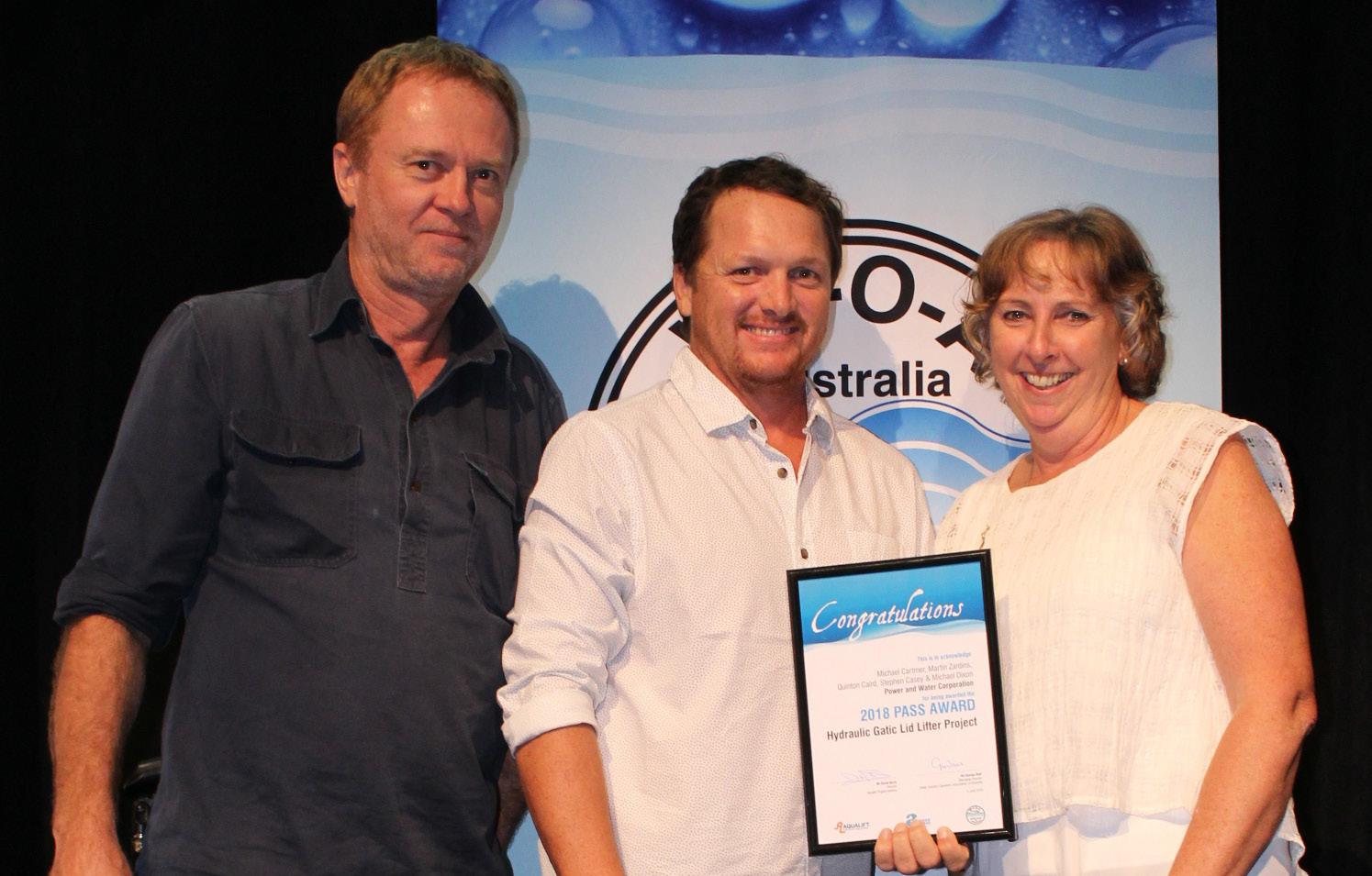
An award providing opportunity for water industry operational staff to share their in the field innovations & fixes to problems so that others in the water industry can benefit.

2018 PASS Award Winner PASS Award winners Martin Zardins and Stephen Casey from Power and Water with Jillian Busch from Aqualift Project Delivery.
Hydraulic Gatic Lid Lifter
Michael Dixon, Michael Cartmer, Martin Zardins, Quinton Caird & Stephen Casey
Remote Reticulation System Programmable Automatic Flushing System
Toby Spark
T.I.M.S. (Totally Independent Managed Supply)
Bradley Milfull & Steve Young
Inspection Hatches for Smoke Detectors
Colin Ellett
H2S Remote Monitoring and Reduction
Daniel Curran
ATUM: Advanced Tertiary Ultra Filtration Management
Jennifer Dreyfus
Stop Tap Removal Tool
Luke Davidson
A Visual Tool Combining Best Practice Operations and Health
Matthew Robertson & Stephen Westgate
Optimisation of Biosolids Transport Management
Peter Uwland
Advanced Aeration Control
Caroline Herman
Adelaide Services Alliance’s Advanced Customer Complaint Mapping Program
Julien Anese

2018 WINNER
Hydraulic Gatic Lid
Lifter
Michael Dixon, Michael Cartmer, Martin Zardins (Mechanical Fitters) Quinton Caird and Stephen Casey (Retic Plumbers) Power and Water Corporation
THE PROBLEM
What was the problem that you experienced? Gatic lids that have been in service for several years without being opened or are in a high traffic area, are often stuck so tightly that they cannot be opened using the standard method.
How did the problem impact you or your work situation?
Lifting gatic lids poses serious manual handling issues for operators. Prior to the introduction of the Hydraulic lifter, it was necessary to bring in heavy equipment to either pop the lids or remove and replace the whole tablet.
How long had the problem been occurring? This has been an ongoing problem for Power and Water Corporation operators for many years.
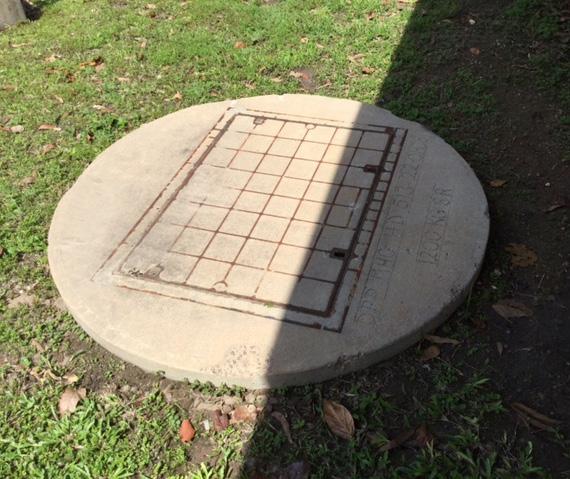
THE SOLUTION
How did you come up with the solution?
The Sewer Reticulation Operators approached the Mechanical Maintenance group with a hydraulic cylinder and a problem. They mentioned how they had to get contractors in with heavy machinery on a regular basis to pop stuck Gatic lids, and asked the Mechanical Maintenance group if it was possible to develop a hydraulic lifter. After several welding bench discussions and chalk drawings the final design was agreed upon.
Who helped work on the solution?
Michael Dixon, Quinton Caird, Stephen Casey, Michael Cartmer and Martin Zardins are acknowledged for their contribution to the project.
Describe the solution.
The solution was to fit two hydraulic cylinders to a hand cylinder pump via a three way splitter and isolating valve. Angle brackets and Tee bolts were fabricated and fitted to the cylinders. All this allows for the lids to be hydraulically lifted with the ability to pump on one lifting point or both at once, this is especially helpful if the lid is not lifting evenly.
How has it helped you at work?
Prior to the implementation of the hydraulic lifter, it was common-place to bring in heavy equipment to either lift the lid or replace the complete tablet. Since using the new lifting equipment, there has only been one lid that needed replacement and this was already broken before works commenced.
Suggest improvements, if time or financial limitations were not a factor. Suggestions have been to make the hydraulic lifter out of lighter material and attaching lifting handles, although it is not overly heavy as it is.
Any other comments you would like to make?
The photo’s below do not show the isolation valves, as they were fitted after the construction of the prototype.
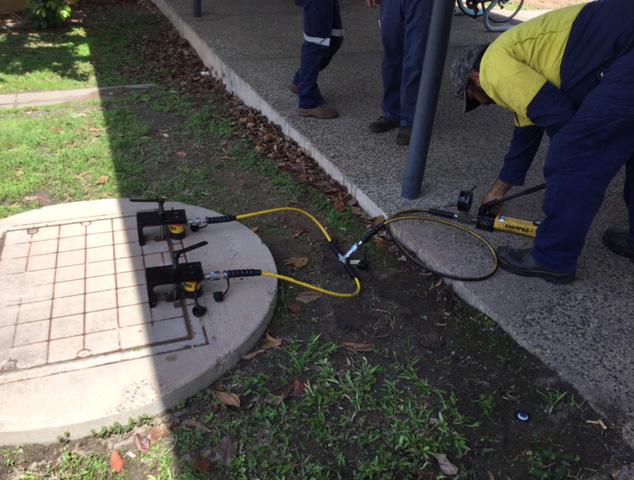
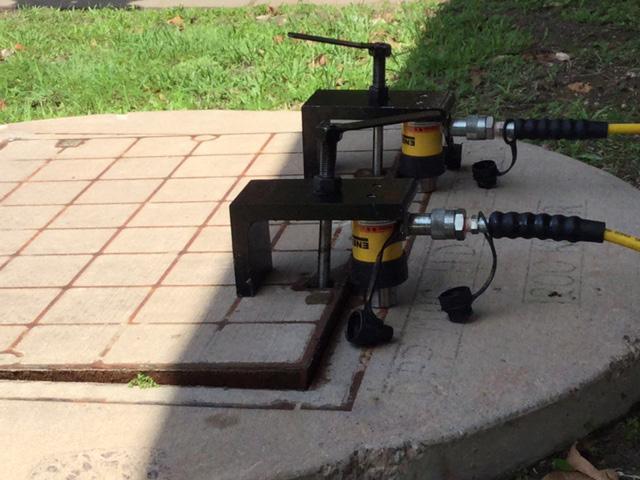
The hydraulic lifter in action
Remote Reticulation System Programmable Automatic Flushing System
Toby Spark, Water Quality Technician, Gippsland Water
THE PROBLEM
What was the problem that you experienced?
The time it takes for water to travel from its source to our customers in long mains or low flow systems, contributes to issues associated with maintaining disinfection residuals, taste, odour, and microbiological compliance in line with Safe Drinking Water Act 2003 (SDWA) and Australian Drinking Water Guidelines (ADWG). To counteract ‘water age’, mains flushing is undertaken to maintain water quality; however, some mains flushing during the day creates pressure issues for customers, requiring flushing at night. This is an additional cost for operations at Gippsland Water.
How did the problem impact you or your work situation?
Water age and quality issues have required operators to attend sites multiple times per week to flush water until water quality standards, such as turbidity and chlorine residuals, are achieved. This sometimes meant competing with other operational priorities such as sampling, attending to customer queries, and operating and maintaining disinfection sites. Flushing and testing also resulted in the inefficient use of time, as flushing may take an hour or longer and the hydrant cannot be left unattended.
How long had the problem been occurring?
The problem has occurred for years across the entire Gippsland Water region where flushing programs are in place. This creates issues particularly during water restriction periods when flushing is required to maintain water quality standards and public health – the public expect water conservation to be undertaken; however, there is a perception that we are wasting water. Seasonal issues also drive increased workloads in winter when there is low flow, and peak times during summer in small towns when everyone is on holiday.
THE SOLUTION
How did you come up with the solution?
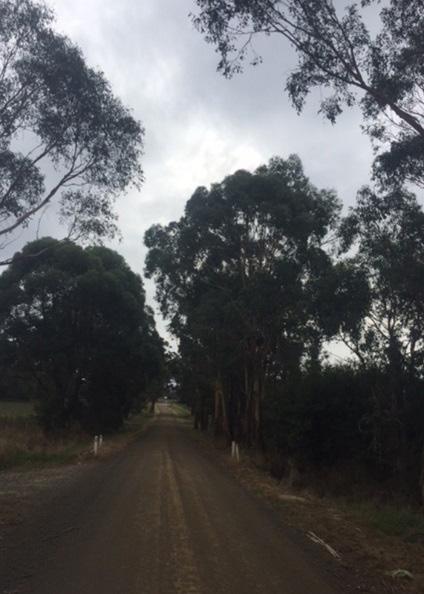
The older, less efficient auto flushing solenoid systems that had been installed previously, had all been removed due to failure. However, it was thought that we could do this better and smarter because the continual flushing was not truly representative of the water quality the customer may receive. The aim of the chosen solution was the continuity of water quality to the customer. Who helped work on the solution?
Gippsland Water’s Water Quality team collaborated to take into account all issues across the region for a single solution option. Kiel Industries assisted with the design for a lockable meter box.
Remote water main with one customer at end of 7-8km 100mm main
Describe the solution.
An auto flushing system is contained in a lockable meter tub that can be buried. An auto flusher is tapped on the main directly for the best outcome. The lockable tub contains a battery timer to control the solenoid to open and close the auto flusher, and the timing is determined by the main size and exchange rate required. The tub also has enough space for a water quality logger (Chloroclam®) with SIM card to remotely monitor and assess water quality (chlorine) to ensure safe drinking water is maintained. The timer is then adjusted as required to ensure flushing time is sufficient to ensure water quality standards (chlorine) are maintained at a minimum safe level.
Flushing occurs at night when flows are at its lowest. As a result, pressure issues are removed and public perception is managed. The drain can be directed to stormwater or gutters for controlled release. The solution is made from readily available materials from hardware shops, including the pipe, agricultural timers and solenoids etc., therefore maintenance and replacement costs are minimal. Once the flushing time is established with the logger, periodic operational checks occur (currently every two weeks) and the logger is moved to the next site being established.
How has it helped you at work?
The solution has seen many benefits including the following:
• Reduced travel time and non-productive work time associated with attending site.
• Ensures flushing occurs as scheduled and therefore weekends and public holidays are not an issue.
• Continued water quality data monitoring helps assess timing issues.
• Data drives response and frees up the water quality technician to juggle competing priorities.
• Less customer complaints associated with flushing occurring at night.
• There is less system shock that can occur when a hydrant is opened up inadvertently creating water quality issues.
Suggest improvements, if time or financial limitations were not a factor.
The solution could be improved by adding trends to SCADA, and critical control point (CCP) alarms could be assigned so that when flushing is complete, on-call staff are able to be notified if minimum disinfection residual is not achieved. There is also potential to add a de-chlorination system for the flushed water as residuals increase.
Any other comments you would like to make?
This system makes the water quality technician’s life much easier and enables them to spend more time on system performance optimisation and drinking water supply operational activities such as basin/storage inspections and tank cleaning. The system is saving 3-5 hours of technician time a week in one system alone.
Lockable tub with meter, timer, solenoid and water quality data logger
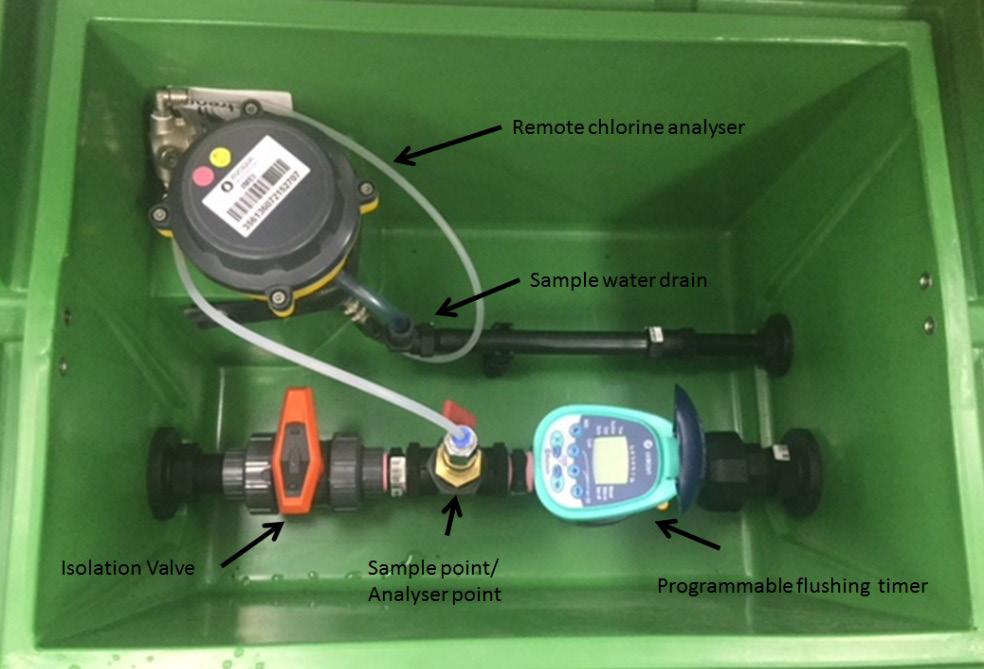
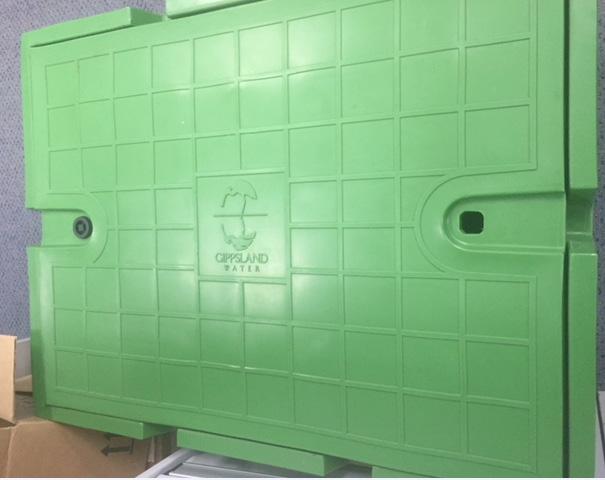
T.I.M.S. (Totally Independent Managed Supply)
The Temporary Emergency Water Supply Solution
Bradley Milfull / Steve Young, Private Works Supervisor / Water Projects Supervisor, Logan City Council
THE PROBLEM
What was the problem that you experienced?
When a water main either bursts unexpectedly or the water supply is isolated for a planned water outage, residents are inconvenienced for an extended period of time without water supply.
When these situations occur, no matter whether forewarned or not, Councils Customer service section would experience a large amount of complaints from affected residents / businesses regarding the water outage.
Also, with Councils newly implemented network water pressure management system, the isolation of the network has become more critical in these type of situations, as a larger area could potentially be affected by a water main burst or planned water outage.
How did the problem impact you or your work situation?
The unexpected water main burst or planned water outage has potentially become a significant issue for Council’s Customer Service / Field crews. They are having to deal with the affected residents / businesses when they should be concentrating on the work that is required to be performed to reinstate the water supply to the affected properties.
This issue is also heightened when Kidney Dialysis patients become involved, as there are a significant number of people with this condition residing within the Logan water supply area They require constant potable water supply to operate their life sustaining equipment.
How long had the problem been occurring?
Logan Water Operations have experienced this issue for years now and have relied on letterbox notification’s as well as the understanding of the affected residents and business’s to allow the field staff reasonable time to effect repairs/ perform required works.
With increased public expectations on water service supply, the residents and business owners are less patient with regards to water outages and the amount of time that it now takes field staff to perform required repairs, with all the constraints imposed on the work and the crews such as fatigue management, WH&S requirements, material shortages, etc.
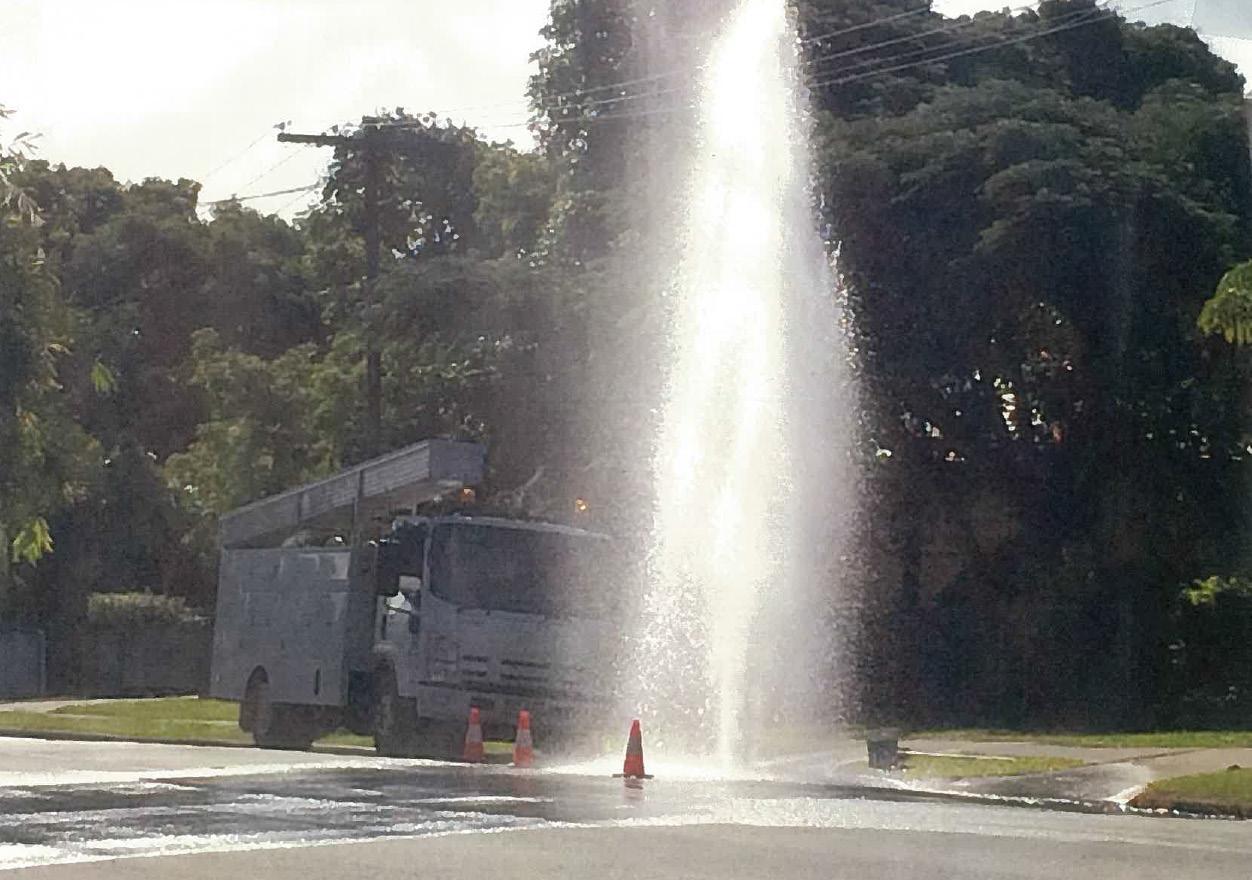
Spring-top Fire Hydrant. Example of an incident causing water outages
Burst
THE SOLUTION
How did you come up with the solution?
It was identified by several of the Operational Water Staff that a better more efficient way to perform water main isolations within the existing network needed to be developed. The first stage of the development was the camel, which is a mobile 1500 litre trailer mounted water tank with a petrol & electrical pressure pump that was utilised to provide critical individual properties water supply during supply interruptions.
With the reconfiguration of the water supply network, there was a need recognised to improve on the small tanker supply system to be able to supply much larger areas which is when the Totally Independent Managed Supply (T.I.M.S.) system was developed out of a necessity to meet these needs.
Who helped work on the solution?
This equipment has been developed in collaboration with several different sections within the Logan City Council, Water Operations Branch over the last 2 years.
The Water Operations Water Projects section were involved in the initial concept, procurement and construction of the equipment under guidance from the Network Operations Supervisor whom provided the technical direction / instruction during the construction phase.
The Water Operations Mechanical & Electrical section provided assistance with the on-board telemetry and electrical installation.
The ongoing tactical deployment, operation and maintenance of this equipment is currently performed by the Water Operations Special Projects section
Describe the solution.
The T.I.M.S. unit is a self-contained and supported temporary water supply that can be hooked up to existing isolated infrastructure via a hydrant standpipe connected to an existing spring top fire hydrant within the isolated network. The unit consists of a 13,000 litre poly water tank which is connected to a 2 stage Variable Speed Drive (VSD) pump which is powered by a 9kva diesel electrical generator The entire unit is currently mounted on a steel cradle with skids.
The unit has the ability to have the water storage volume increased by a further 13,000 litres by connecting and additional tank (also skid mounted).
The T.I.M.S. unit and associated equipment is currently licenced under the Food Act 2006 due to water being identified as a food product, it also complies with required backflow prevention regulations by having a registered backflow prevention device installed on the tank fill point.
This unit has also been setup with telemetry monitoring equipment so the operation of the unit can be monitored from a remote location by designated staff, so that it does not need to be physically manned unless the unit requires refuelling or the water tank needs filling.
How T.I.M.S. has helped at work!
The T.I.M.S. unit has significantly improved Logan City Council, Water Operations ability to efficiently supply potable drinking water to residents constantly at normal mains pressures during both planned and nonplanned supply outages.
The unit has recently been used to supply potable water to up to 500 metered properties during a planned water outage when maintenance works was required to be performed on a critical trunk water main.
Suggested improvements, if time or financial limitations were not a factor.
There is currently a second unit in the design phase which will incorporate additional features such as:-
• The unit will be mounted on a wheeled mobile platform / trailer fitted with stabilisers to assist with weight distribution and unit levelling.
• Improved security measures to aid in the prevention of vandalism when the unit is unattended out on site, possibility of video security cameras connected to the telemetry system.
• Improved method of safe access to tank inspection hatch for cleaning and maintenance / inspection issues.
• Improvement of the current skid mounted tank cradle to allow better manoeuvrability when loading and offloading on site.
Any other comments you would like to make?
Since initial deployment on 8 March 2016 the unit has supplied potable water to in excess of 20,000 metered properties during its life. The current unit has undertaken 1,200 hours of tactical deployment and the longest continuous operation of the unit is 258.9 hours.
With the customers that are eliminated from loss of supply, the water quality and supply is not compromised or contaminated (e.g. negative pressures in the main due to the depressurisation/ dewatering ) during the use of the T.I.M.S. unit.
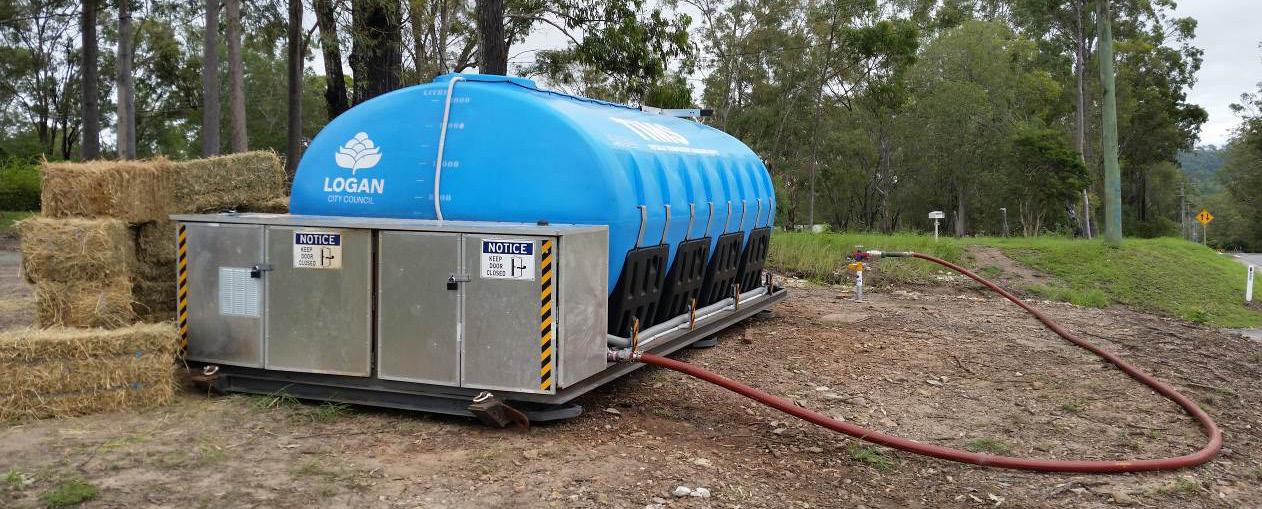
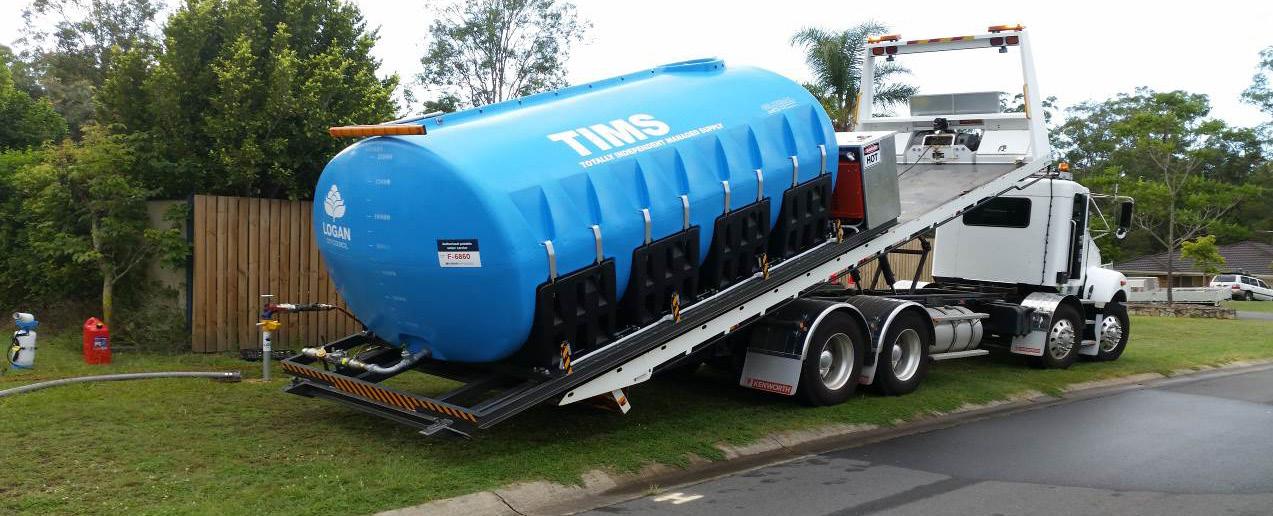
Stanmore Road T.I.M.S. deployment during flood repairs
Delivery of T.I.M.S. unit to site
Inspection Hatches for Smoke Detectors
Colin Ellett, Maintenance and Special Projects Supervisor, Veolia
THE PROBLEM
What was the problem that you experienced?
When constructed Bendigo WTP had smoke detectors installed in the main filtration building as per building requirements. Then all of the Microfiltration cells and associated equipment were installed in the building and unfortunately, compromised access to the smoke detector units which are placed on the roof structure.
How did the problem impact you or your work situation?
The detectors need to be periodically inspected and replaced as necessary, but because of pumps, pipework and other pieces of equipment there was no way to use a scissor lift or any type of equipment to gain access to them.
How long had the problem been occurring?
The problem had existed since the plant was built in 2001.
THE SOLUTION
How did you come up with the solution?
The problem was solved by one of our Operators, Andrew Naughton, who also happens to be an electrician. He devised a plan to install inspection hatches on the building roof so that the maintenance staff could reach down, unclip the detector and bring it onto the roof for maintenance or replacement.
Who helped work on the solution?
Andrew was the lead on the project and 2 of our other operators who happen to be plumbers did the install work after having the hatches folded up by a local sheet metal company and then installing them on the roof of the building.
Describe the solution.
Simple small hatches that can be removed by taking out a few tek screws allowing access to the smoke detector. Cost for the hatches was around $2500 and all the labour was supplied internally so this was a very low cost fix.
How has it helped you at work?
Maintenance can now be performed when required with ease and much more safely than previously.
Any other comments you would like to make?
Andrew provided a very low cost option to allow maintenance to be completed on very important safety equipment.
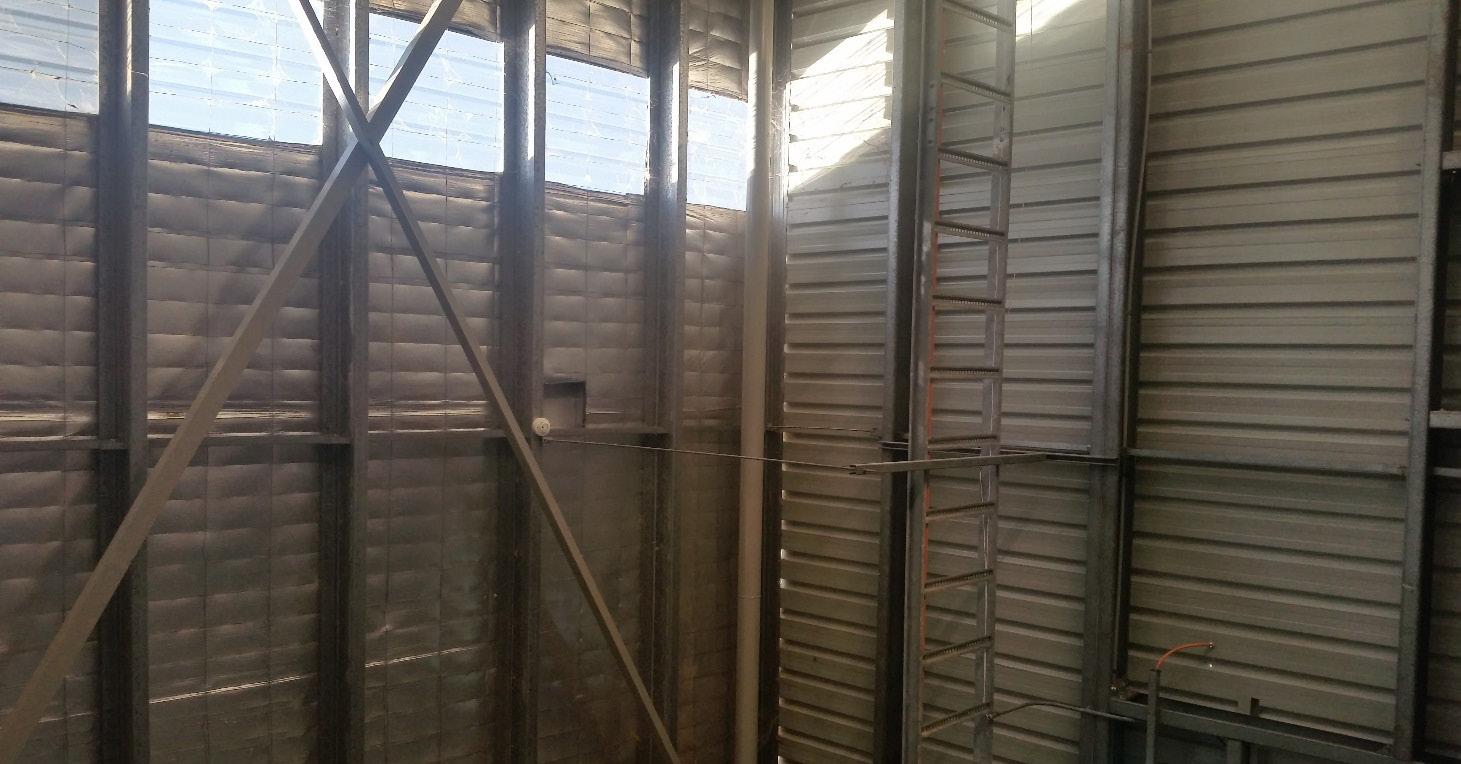
Location of the smoke detectors in the membrane building
H2S Remote Monitoring and Reduction
Daniel Curran, Area Manager, Solenis
THE PROBLEM
What was the problem that you experienced?
In industries with harsh operating environments, maximising the life expectancy of equipment at the lowest possible cost is a strategic priority. This often requires a multi-pronged approach that involves advanced water treatment chemistry, preventative maintenance and resource conservation.
Currently in the wastewater industry there is no process for predicting asset life due to the degradation caused by H2S build-up in the system. Spot sampling is often undertaken as part of maintenance inspections, but the data is not used to great effect.
Solenis identified that corrosion was occurring on mild steel and concrete assets in pump and transfer stations, such as the Cockatoo Pump station in Victoria.
How did the problem impact you or your work situation?
The impact of corrosion on wastewater assets is a health and safety risk through public exposure, with degradation of assets causing reliability concerns.
How long had the problem been occurring?
The problem had been occurring since the transfer of waste started at the pump station in question.
THE SOLUTION
How did you come up with the solution?
By developing a remote real time H2S corrosion monitoring system that monitors and logs the H2S levels and relays mild steel corrosion information.
Who helped work on the solution?
Anthony Brown (Yarra Valley Water).
Describe the solution.
Through the data logging of the corrosion and H2S levels, the current dosing of Magnesium Hydroxide could be optimised. Additionally the consideration of Ferris chloride dosing, a recognised product in the reduction of H2S, can be added upstream and the results monitored and the success rated and optimised.
Ferrous Chloride is a by-product generated through the pickling of steel coil with diluted HCl to remove scale from the steel. Ferrous Chloride has been used in Australia for 25+ years and is an effective chemical for odour control and asset protection in the water treatment industry.
How has it helped you at work?
This solution has aided in predicting asset life of both mild steel and concrete. There has been a reduction of odour, reducing the risk of causing issues for the public.
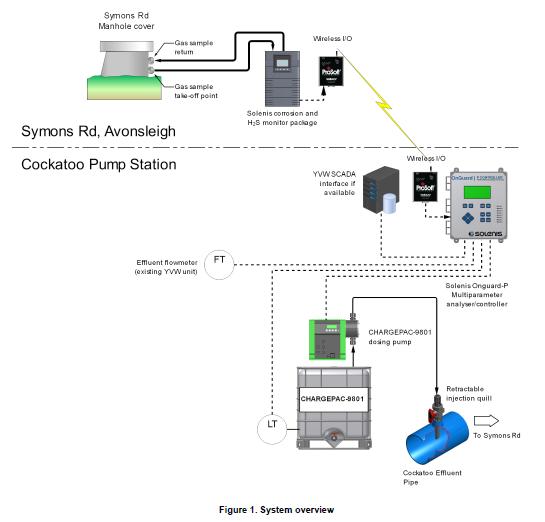
Suggest improvements, if time or financial limitations were not a factor. This was a trial of the concept. It is recommended a permanent installation of equipment be considered, incorporating closed loop control on dosing to manage the chemistry.
Any other comments you would like to make?
This is a long term issue that effects sewerage treatment/transfer systems. Magnesium Hydroxide is traditionally used to address this issue but the effectiveness can be very difficult to quantify and assess.
System overview of the solution at Cockatoo Pump Station
ATUM: Advanced Tertiary Ultra Filtration Management
Jennifer Dreyfus, Process Optimisation Engineer, Allwater
THE PROBLEM
What was the problem that you experienced?
The treated effluent from the Glenelg Wastewater Treatment Plant (WWTP) is used to produce A class irrigation water through an Ultra Filtration (UF) process followed by UV disinfection and chlorination. The A class water is then distributed to a number of customers including the Adelaide City Council, which uses the water to irrigate the parklands around the city, as well as several other resorts and public organisations for irrigation purposes. This recycled plant, called GAP or “Glenelg to Adelaide Parklands”, has been operational for 8 years. Over the years, when the wastewater treatment process had an upset, fouling in the downstream UF membranes was observed, causing early degradation of the membranes. This fouling then triggered numerous backwashes and chemical cleans. As the membranes were coming close to their end of life, this was becoming a bigger problem, and it was putting our supply to customers at risk.
How did the problem impact you or your work situation?
This issue was causing the operational team grief with a requirement to closely monitor plant performance. Indeed, fouling events often required manual intervention in order to keep production levels up. The supply to the customers was at risk during these events, thus putting our business and reputation at risk. It was also a financial problem as it was creating early degradation of the membranes, meaning that the membranes would have to be replaced earlier, potentially incurring major capital investment in the vicinity of 2 million dollars for the business.
How long had the problem been occurring?
The issue became worst as the membranes were ageing and coming towards their end of life.
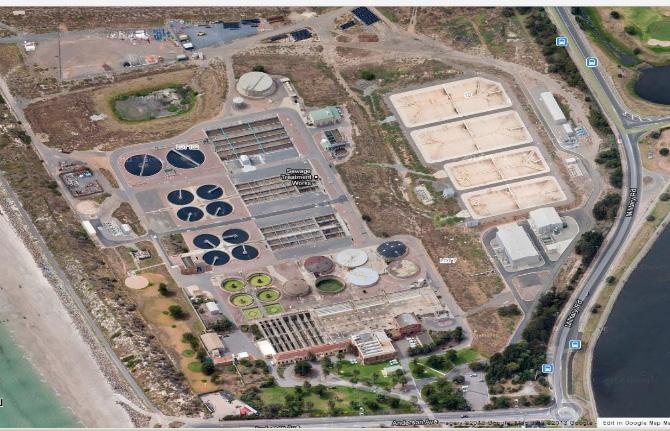

Glenelg Wastewater treatment plant
Fouled membrane
THE SOLUTION
How did you come up with the solution?
The idea emerged at a workshop around the GAP operations with stakeholders from SA Water, Suez and Allwater. The issue was raised that membranes were fouling specifically when the process of the wastewater plant was suffering The SUEZ expert suggested that micro-coagulation prior to Ultra Filtration could be trialled at a full scale to manage these fouling events and mitigate their consequences.
Who helped work on the solution?
Experts and engineers from Suez, SA Water and Allwater helped, as well as the whole operation and maintenance team onsite at Glenelg WWTP.
Describe the solution.
A full scale trial was undertaken from December 2016 to mid-March 2017 (during the high reuse demand period) on the ultrafiltration membranes at the GAP. A test skid was operated with continuous dosing of ferric chloride, at a concentration of 1-2 ppm as pure FeCl3, prior to the UF membranes in order to form pin flocs that provide a heterogeneous coating on the membranes, to protect them from fouling matter. For comparison, a reference skid was operated according to usual procedures and manufacturer recommendations, without ferric chloride dosing.
How has it helped you at work?
The outcomes of the trial were that through full-scale implementation of micro-coagulation process for OUT/ IN pressurised UF membranes, the hydraulic performances of old and fouled membranes during fouling events were improved. Its implementation also ensured robustness of tertiary ultrafiltration operation and performance.
Furthermore, protecting the membranes from fouling events can extend their life and delay major capital investment which is an attractive option for all water utilities. In the case of the GAP RWTP, implementation of this research represents a delayed investment of over 1.9 million dollars. To achieve this result, only minimal capital and operational investment is required to dose ferric chloride prior to the membranes.
Suggest improvements, if time or financial limitations were not a factor. We would recommend spending more on automation, for the process to be run easily.
We would also suggest conducting further investigations to identify relevant feed water quality parameters that can provide early signs of fouling events of tertiary UF membranes.
Any other comments you would like to make?
This project was a great team effort as more than 30 persons were involved to make it happen. It also showed great operational collaboration and dedication as the project was implemented in a very short time.
Stop Tap Removal Tool
Luke Davidson, Senior Civil Maintenance Officer, Central Highlands Water
THE PROBLEM
What was the problem that you experienced?
The problem identified was limited working space in pathboxes. Stop taps have become extremely tight, therefore reporting a number of injuries from use of hammers, shifters and sink spanners when working in pathboxes.
How did the problem impact you or your work situation?
This impacted the workplace with Manual Handling injuries reported and increased time spent completing work associated with these assets.
How long had the problem been occurring?
This problem has been occurring as an ongoing issue for the Central Highlands team. More properties are locating meters in path boxes.
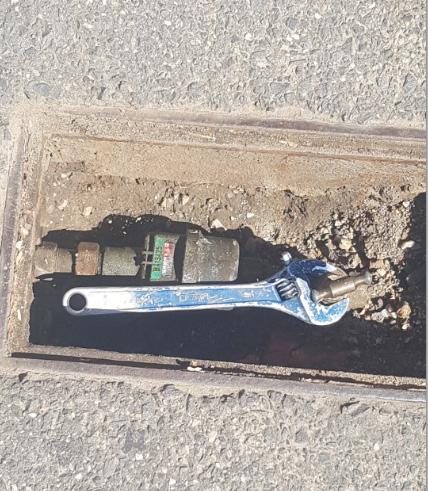
Limited space to work in pathboxes and potential cause of injury.
THE SOLUTION
How did you come up with the solution?
The solution involved working with a local engineering firm to find a solution and produce a better and safer tool for stoptaps in pathboxes.
Who helped work on the solution?
Assistance from Matthew Leehane at Central Highlands Water and an external contractor, Lloyds Fabrication.
Describe the solution.
A compact tool that fits tightly over stop taps was created which utilises valve keys already found on Central Highlands Water maintenance vehicles.
How has it helped you at work?
This solution has helped eliminate workplace injuries associated with using shifters and hammers in pathboxes and making the stoptap process safer. This has also improved time efficiencies and reduced costs to the business.
Suggest improvements, if time or financial limitations were not a factor. No further improvements are needed, it’s a more cost effective and more productive tool.
Any other comments you would like to make?
Suggest other Water Utilities implement something similar to improve their work processes. By using this tool, the task is completed quicker with less precious potable water lost, reducing the need of an environmental impact and requirement to dig up around the meter box to fix.
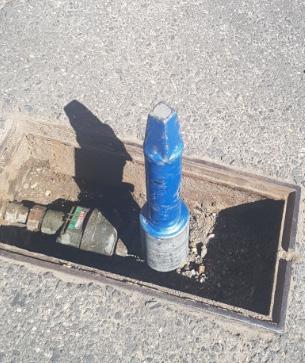
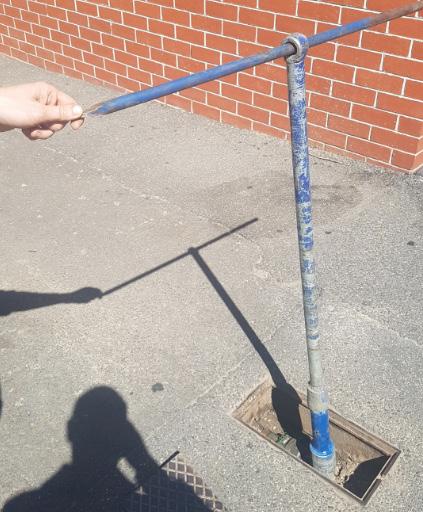
The stoptap removal key fitted onto the stoptap.
Valve key on top of the stoptap removal key
A Visual Tool Combining Best Practice Operations and Health
Matthew Robertson & Stephen Westgate, Process Engineer & Senior Water Quality Scientist, TasWater
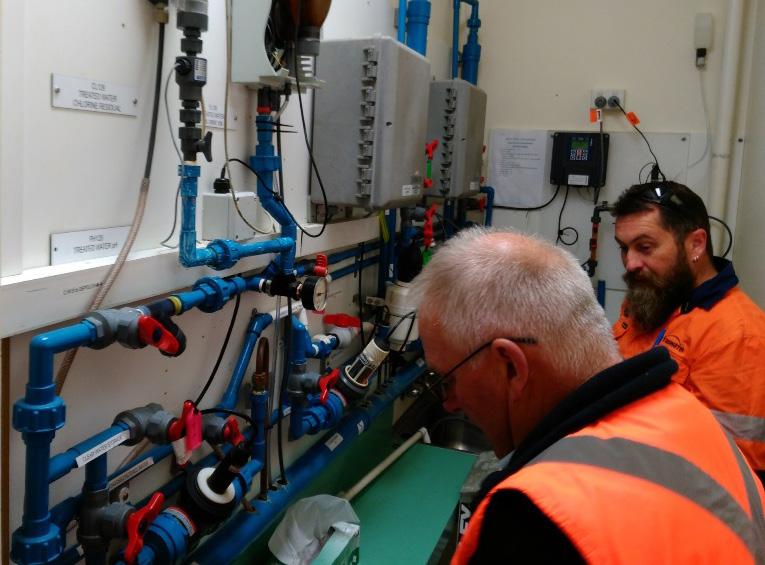
Working with operators to help assist in instrument calibration and faulty signals.
THE PROBLEM
What was the problem that you experienced?
TasWater’s compliance statistics (E. coli) was not representative of the risks and issues operators faced. In other words, some operators were not equipped well enough or risk management plans were not adequately renewed or managed to properly operate the treatment plants.
The impending Health Based Targets (HBT) that are to be incorporated into the Australian Drinking Water Guideline (ADWG) will increase the levels of compliance required from a water authority. We have tried to get on the front foot and incorporate standards into new plants being developed and to retrofit older plants.
How did the problem impact you or your work situation?
The inadequacies at the treatment plants were resulting in a large risk of water quality breaches, which were never identified previously. This risk also places undue stress on operational staff already stretched in their day to day working environment.
How long had the problem been occurring?
This problem would exist within most water businesses, particularly on legacy plants were standards have changed without plant upgrades or operator knowledge being updated.
THE SOLUTION
How did you come up with the solution?
We needed a method of identifying and quantifying this risk. We achieved this by making an assessment method from two Australian Water Publications which are:
1. The “Manual for the Application of Health-Based Treatment Targets” (HBT) (Water Services Association of Australia, 2015)
2. The “Good Practice Guide to the Operation of Drinking Water Supply Systems for the Management of Microbial Risk” (GPG) (Mosse & Murray, 2015)
Who helped work on the solution?
Matt Robertson, Stephen Westgate, Brad Mulcaster, Peter Triffitt, Chris Pieterse, Antoine Chassagne, Brett Pritchard.
Describe the solution.
The solution is a visual representation of water quality risk on a chart. The closer to the bottom left of the chart, the more risk the greater chance of a water quality breach. The vertical axis represents the likelihood of risk (operational deficiencies) and the horizontal axis represents the impact of risk (the treatment deficiencies).
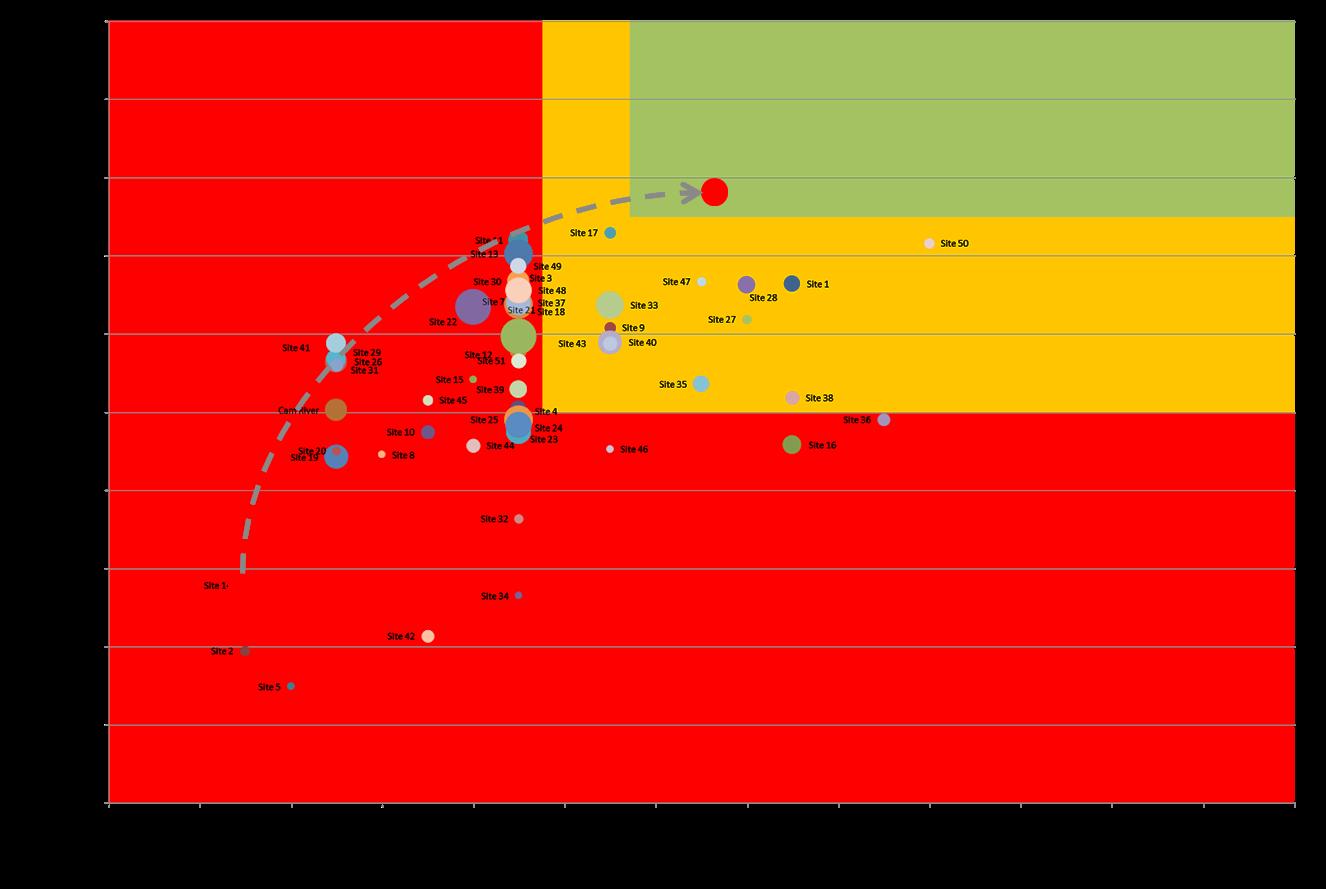
Graphic showing assessed treatment plants, the object is to move plants from the red section to the yellow and ultimately the green section.
The graphical example is showing that, with a combination of jar testing, sampling and instrument calibrations (vertical axis), together with optimisation activities (horizontal axis) that includes filter and clarifier performance activities and the installation of UV treatment, we can move a treatment plant from a very poor risk of water quality issues to a much safer one.
The solution takes critical and complex guides and methods, and presents it in a format that can be understood from the TasWater Board members through to operators.
How has it helped you at work?
It has helped illustrate to the business where and what improvements need to be made. It has also helped fast-track much needed improvements.
One practical result is the implementation and education around Operational Control Points (OCP) and Critical Control Points (CCP). This allows the operator to monitor specific quality standards in the treated water (TW) and provide control measures to prevent water being produced that is outside drinking water quality guidelines i.e. post filter turbidity, filtered water chlorine residual and fluoride (high levels).
It gives the operator more confidence in the plant operated and no doubt relieving a fair amount of underlying stress when running either an older plant with inherent problems or being able to focus on what’s important while getting their heads around a new plant.
Suggest improvements, if time or financial limitations were not a factor. This was only undertaken once, and the risk needs to be assessed periodically. Therefore, we would need a team to re-assess these systems. Implementation of any required asset renewals to assist the process can take considerable time, depending on individual plant situations.
Any other comments you would like to make?
For the operator, the work has highlighted the importance of critical control points at water treatment plants, in particular with filtered water turbidity, chlorine dosing and fluoridation levels in the final water. It also gives direction to the business where to put its capital investments in a targeted style according to maintaining compliant water quality, potentially saving on holding back large capital outlays.
Optimisation of Biosolids Transport Management
Peter Uwland, Treatment Operations Coordinator, Wannon Water
THE PROBLEM
What was the problem that you experienced?
Dewatering Waste Activated Sludge from the IDEA sewage treatment plant at Warrnambool is via two separate belt filter presses. Previously, there was no way of determining when the sludge cartage contractor‘s sludge bins were full by weight. Instead, this relied on an operator being present on site, visually checking the bin volume and making an estimation on time, experience and visual volume. There was no weighbridge onsite and the contractor was transporting loads to the nearest weighbridge some 15 kilometres away.
With many variables (MLSS, solids concentration, solids dryness, poly batching, wash water, etc) it was challenging to get a consistent load of biosolids into the trailer bins. On occasion it led to overfilling the trailers by several tonnes. This meant either unsafe loads being transported, overspill, or having to drop biosolids on the ground. There were significant costs in down time and contractor/equipment hire, and an increased risk to OHS and the environment.
How did the problem impact you or your work situation?
It was an impact on operator efficiency (having to be onsite, constantly checking), OHS for accessing the top of bins for visual checks, OHS for contractor taking away overweight loads, cost efficiency in cartage (under weight, over weight), high overtime costs with operators working after hours and on weekends.
How long had the problem been occurring?
This has been an issue at the Warrnambool sewage treatment plant for over 25 years (the life of the current plant). There had never been a reliable way of determining the correct weight of biosolids in the bins at this site.
Wannon Water undertook investigations into installing trailer scales onsite, which found that a project of this scale, including design, excavation, installation and purchasing, would cost in excess of $600,000.
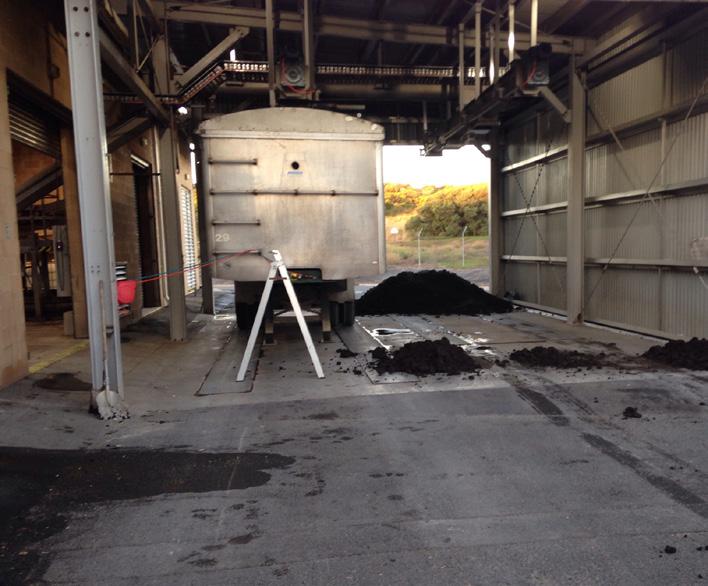
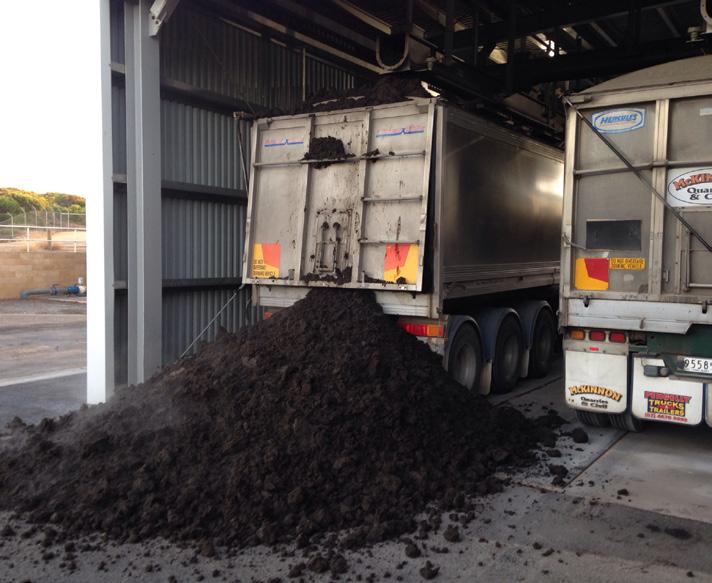
Examples of the OHS and spillage problems at the IDEA sewage treatment plant at Warrnambool
THE SOLUTION
How did you come up with the solution?
When connecting for the removal of the biosolids, the current contractor would typically hook up the truck’s air supply for the trailer’s airbag. The trailer had a pressure gauge on the side. We started checking the pressure gauge against the weigh dockets and found that we could pretty closely guess when the bin was full, purely based on air pressure.
Who helped work on the solution?
The solution was a joint effort between Wannon Water’s Treatment Operations team, the Mechanical, Electrical and SCADA team and the external biosolids contractor.
Describe the solution.
Firstly, we connected a constant air supply to the trailer bins off our existing air compressors for the Belt Filter Press. This helped the operator read the trailer’s pressure gauge to determine how full the sludge bin was.
Secondly, we installed a digital pressure transducer/transmitter connected to a second air hose off the trailer’s air supply. We connected this pressure transducer/transmitter to our Citect and the SCADA team programmed the gauge pressure and controls. This then gave the operator a constant Citect reading on pressures and trends. It also allowed the trailer bins to swap duties when the pressure set-point was reached, or shut down the whole dewatering process if both sludge bins were full, or if there was no bin present.
How has it helped you at work?
In regards to weight of 27 tonnes of biosolids per trailer, we were able to fill the bins to within 200 kilograms of full capacity. Prior to this it was easy to go several tonnes over or under the 27 tonne capacity. This meant increased efficiency in ensuring every load going offsite to our drying facility was being optimised.
The next bonus was the ability to operate the belt filter press outside normal hours and have the confidence to fill the trailers and rely on the system shutting down. This was extremely useful during the recent upgrades where the original 25-year-old belt press was decommissioned and replaced with a centrifuge. During that project, we went from being able to waste MLSS (Mixed Liquor Suspended Solids) at approximately 40 L/s to less than 20 L/s for several months. The sludge bin pressure system allowed us to operate extended times and weekends to maintain tank MLSS and sludge age.
The whole project cost less than $10,000 in goods, equipment and labour, yet delivers huge ongoing cost savings for Wannon Water
Suggest improvements, if time or financial limitations were not a factor. Installation of weighbridge/trailer scales.
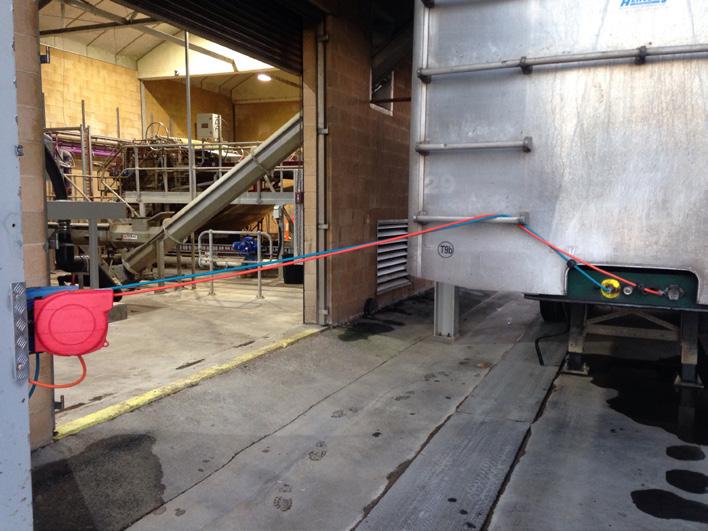
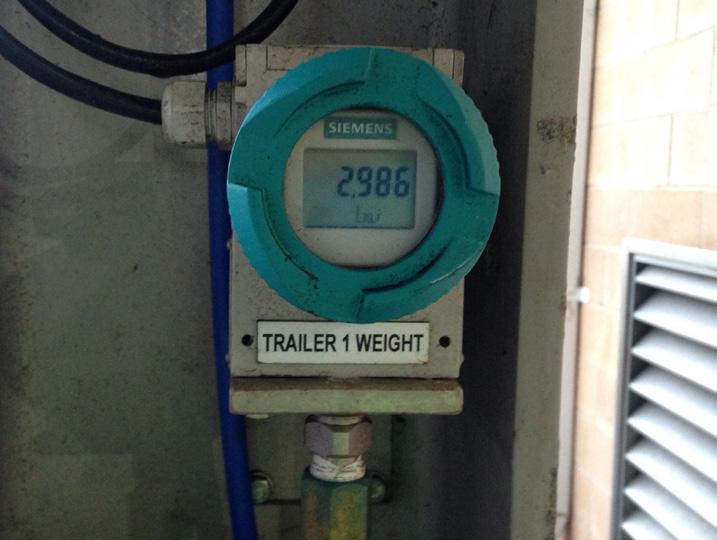
Pressure measurement installation to measure the amount of sludge loaded into trailers.
Advanced Aeration Control
Caroline Herman, Site Engineer, Allwater
THE PROBLEM
What was the problem that you experienced?
Due to variations in plant influent load and limitations in real-time process control, Christies Beach WWTP experiences unstable plant performance. The plant is fed by a wastewater network mainly connected to seaside councils, and thus typically experiences higher incoming pollution load over the week-ends, which then lead to potential nutrient breakthrough, especially during high flows. Discharging into the gulf Saint Vincent, Ammonia is one of our main water quality targets with a limit of 1mg/L to respect.
Using traditional Dissolved Oxygen (DO), Red-Ox or Oxygen Uptake Rate aeration control, operators can monitor that the right biological process are taking place, but monitoring their effectiveness is another story, involving sampling, analysis and on-going optimisation.
In parallel, power supply instability and increasing power prices in South Australia have led to a shift in operational focus towards reducing consumption of major power-intensive equipment, of which the most intensive in a WWTP are aeration blowers.
How did the problem impact you or your work situation?
The problem impacted the plant’s team of operators and process technicians who are required to closely monitor plant performance on a daily basis. Considerable amounts of time and resources go into testing effluent water quality. Subsequent changes to aeration set-points and asset set-up are then made according to results.
How long had the problem been occurring?
Performance issues have been ongoing since the commissioning of the plant.
Power prices have been driven up over the last few years with the shut-down of coal-fired power plants around the state, thus increasing pressure on the remaining renewable power plants and gas-fired power plants.






How did you come up with the solution?
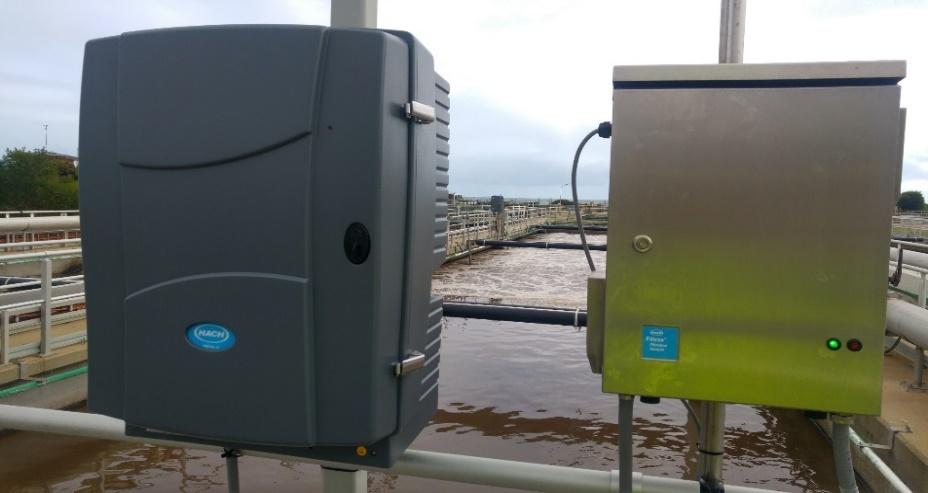
Aeration control improvements were identified as a way to reduce energy demand while guaranteeing nutrient removal targets. The idea emerged to adjust aeration based on the incoming pollution load, thus tailoring our process to our exact needs. A study was carried out in 2016 to determine the feasibility of redesigning and applying an existing Suez control algorithm, Greenbass™, on-site at Christies Beach WWTP. The project was presented to our Alliance partner, SA Water, who validated the concept and agreed to finance its implementation.
Who helped work on the solution?
Suez developed the control algorithm and SA Water financed the project. Experts from Suez, Clement Roche and Marie Secondat, assisted the site engineers, Amin Malekizadeh and Caroline Herman, and the automation coordinator, Steven Lamble, with the integration of the algorithm and the commissioning of the control system. The team of fitters and electrician installed the new instrumentation and modified the existing assets to suit. The plant supervisor and process technicians monitored and operated the solution on a daily basis. The technical transfer manager focussed the budget, timing and aspects of the project.
Describe the solution.
A full-scale trial is currently underway at Christies Beach WWTP using Advanced Aeration Control to accurately match aeration needs with real-time Ammonia load measurements, with the focus on improving energy efficiency and nutrient removal.
In order to implement Advanced Aeration Control at Christies Beach WWTP the following steps were undertaken:
• Review and benchmarking of existing technological solutions allowing online Ammonia analysis, and reliable instrumentation for Advanced Aeration Control
• Review of plant layout, assets and operational data to determine best location for analyser installation
• Purchase and installation of Ammonia Analysers and automatic sampling units.
• Data collection for development of the plant’s baseline plant performance
• Integration of Greenbass™ Plug Flow algorithm into the PLC and development of a new SCADA interface for enhanced control
• Commissioning of AAC system and adjustment of operational parameters and correction coefficients.
• On-going daily review of operational performance including airflow,
• On-going regular laboratory analysis to monitor the trial treatment line’s performance against the reference treatment line in terms of Ammonia removal
Figure - AAC Inlet Ammonia Analyser Installation
Christies Beach WWTP A/B Plant and Ammonia analyser location
AAC Inlet Ammonia Analyser Installation
How has it helped you at work?
After their installation early 2017, the Ammonia analysers have been providing accurate and reliable online data with which advanced aeration control could be confidently based on.
Using preliminary results, the following benefits were observed:
• When running the system under the predictive mode only, savings in terms of aeration amounted to a median of 1692kg of air per day, or 5.4% savings. Similarly, when running the system under the combined predictive and removal efficiency feedback mode, savings in terms of aeration amounted to a median of 1501kg of air per day, or 5.3%.
• In terms of external carbon source addition, running the system under the combined predictive and reactive mode, savings amounted to a median of 45L of pure Ethanol per day, or 38% savings over the period of time the combined mode was active.
If Advanced Aeration Control was applied across Christies Beach WWTP, based on FY 2016-2017 figures, we would reach power savings in the order of 130MWh per year. Economically, this would represent approximately $15,000, using average spot market prices. In terms of ethanol, based on FY 2016-2017 figures, we would reach savings in the order of 55kL of ethanol, which represents about $60,000.
Suggest improvements, if time or financial limitations were not a factor. We could have invested more in the SCADA integration to make the system more user friendly. We could also have invested in additional Ammonia analysers which could have enabled us to extend the trial further across the plant.
Any other comments you would like to make?
Greenbass™ was awarded the 2011 European Environmental Awards or EEP Awards (Prix Europeens de l’Innovation Environnementale), awarded at the Pollutec exhibition.
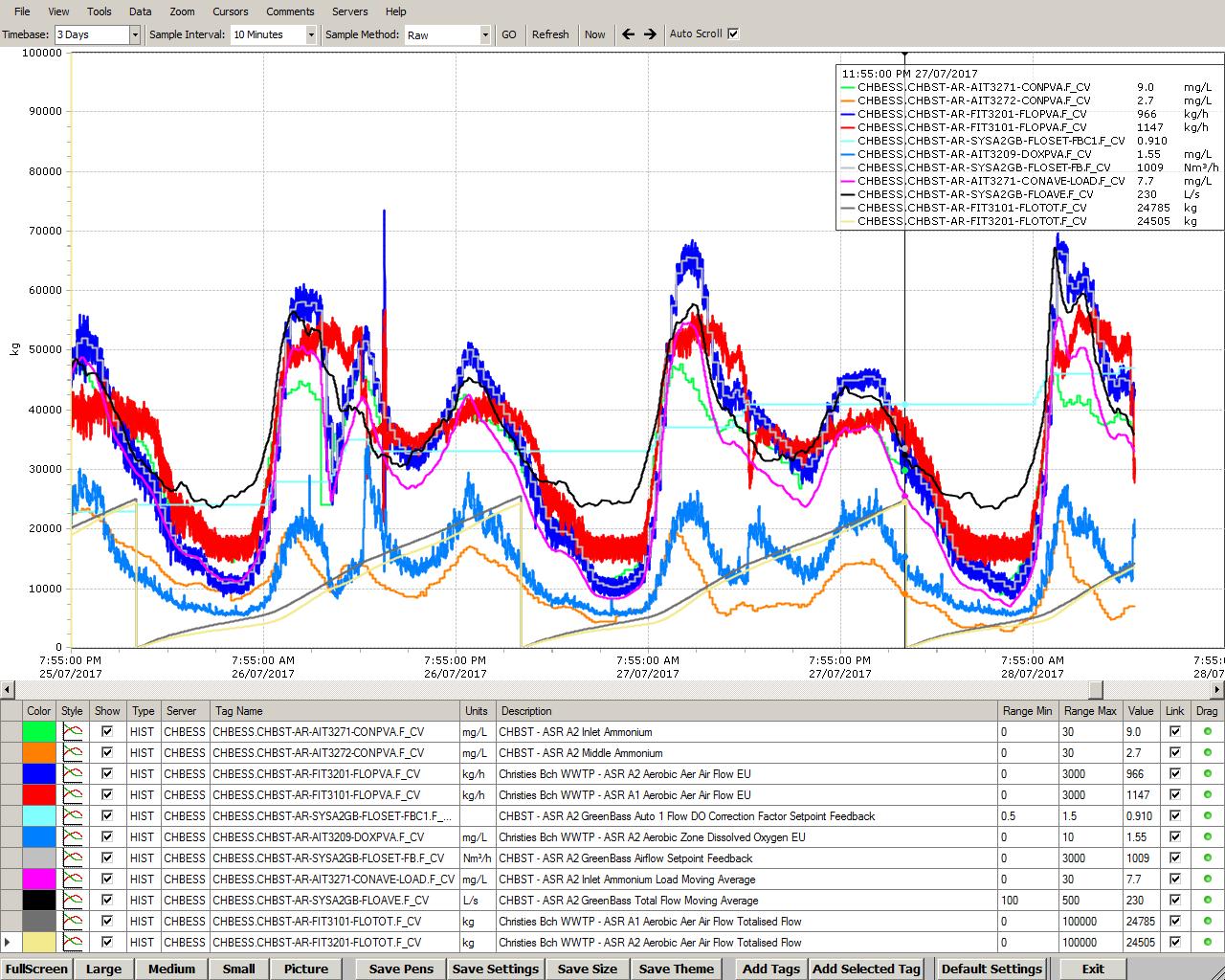
Adelaide Services Alliance’s Advanced Customer Complaint Mapping Program
Julien Anese, Centralised System Support Manager, Allwater
THE PROBLEM
What was the problem that you experienced?
Allwater and SA Water work together to operate and maintain Adelaide’s metropolitan water and wastewater systems. This Adelaide Services Alliance is committed to consistently supplying quality and affordable water services to metropolitan Adelaide’s 1.3 million customers. During 2016-2017, water quality complaints represented more than 40% of the total number of complaints received from customers. No complaint mapping tools were available to 24/7 customer care centre or operational teams. An on-call water quality operator was used to manually map water quality customer complaints as they were reported. This map can be used to determine clusters of customer complaints and to facilitate escalation to the incident manager.
How did the problem impact you or your work situation?
It was not possible to anticipate clusters of complaints. As a result poor information may have been provided to customers, potential disruptions and impacts to water quality and on-call operator. The operators also experienced many redundant work orders for a single event between Customer Care Centre and Dispatch. Additionally, it was not possible to track a substance in the drinking network during an event.
How long had the problem been occurring?
This problem had been occurring for some time. It became an increasing priority for Allwater and SA Water from July 2016, in their drive to become more customer-centric.
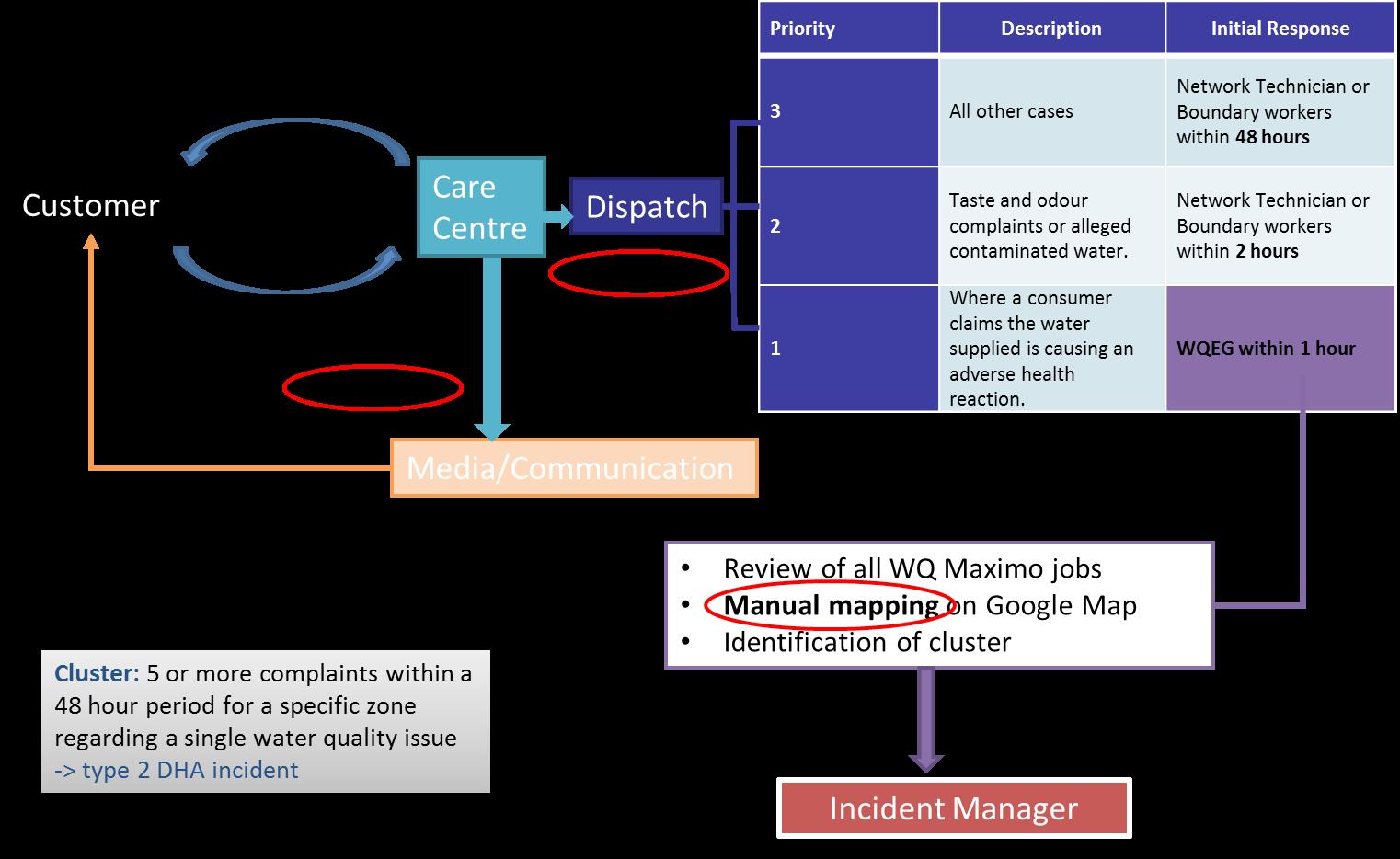
THE SOLUTION
How did you come up with the solution?
The solution involved the use of GIS, hydraulic modelling and incorporation of a customer centric focus to the new tool. Further improvements were possible by discovering new Excel features (Power Map).
Who helped work on the solution?
Several business units were involved including; Network Water Supply, Water Quality, Technical Support Officers, Network Technicians, Customer Care Centre, Service Continuity, Operations Control Centre, Water and Wastewater Assets. All these teams provided constructive feedback and improved significantly the prototype. The SA Water IT department particularly helped for the data connections.
Describe the solution.
A program, Advanced Customer Complaint Mapping Program (ACCMP), has been developed by Allwater and SA Water to enhance the customer experience. It aims to map real time customer complaints with Microsoft Excel Power Map and automatically identify clusters of customer complaints, thereby allowing for more rapid operational intervention. ACCM collects real time data from an asset management system (Maximo) and a Laboratory Information Management System (LIMS). This live tool is used across the Adelaide Services Alliance (Allwater and SA Water), by 24/7 customer service and operational teams (water quality, network, treatment plant).
The Advanced Customer Complaint Mapping Program has had a number of innovative aspects, including:
• Use of latest Microsoft Excel mapping features (Power Map)
• New method of geographical and temporal data visualisation
• Real time data queries from Microsoft Excel to Maximo and LIMS
• Automatic identification and alert of clusters of complaints
• Helps to diagnose the cause of the complaint
• Tracking of water quality events in the network
• Creation of time-lapse video for communication during/after an incident
• Possibilities for development of this tool for any type of customer complaints

ACCM - Example of data card window pop-up with information taken from the mapping tool
How has it helped you at work?
It is now possible to anticipate a cluster of complaints, resulting in a better experience to customers, less disruption for on-call operators, and no redundant work orders for a single event between Customer Care Centre and Dispatch.
• With no capital outlay, the mapping tool is excellent value
• Reducing impact on water resource (less time to fix water main failures) and impact on environment (H2S release) is beneficial from an economical point of view.
• Reduce waste of drinking water by fixing water main failures faster
• Reduce H2S release by fixing wastewater infrastructure issues faster
Suggest improvements, if time or financial limitations were not a factor.
A process is currently to implement an Advanced Customer Complaint Mapper into SA Water corporate solutions, named Aquamap (robust GIS viewer, well-maintained, available to anyone).
Any other comments you would like to make?
This solution won the AWA program innovation award for SA in November 2017.
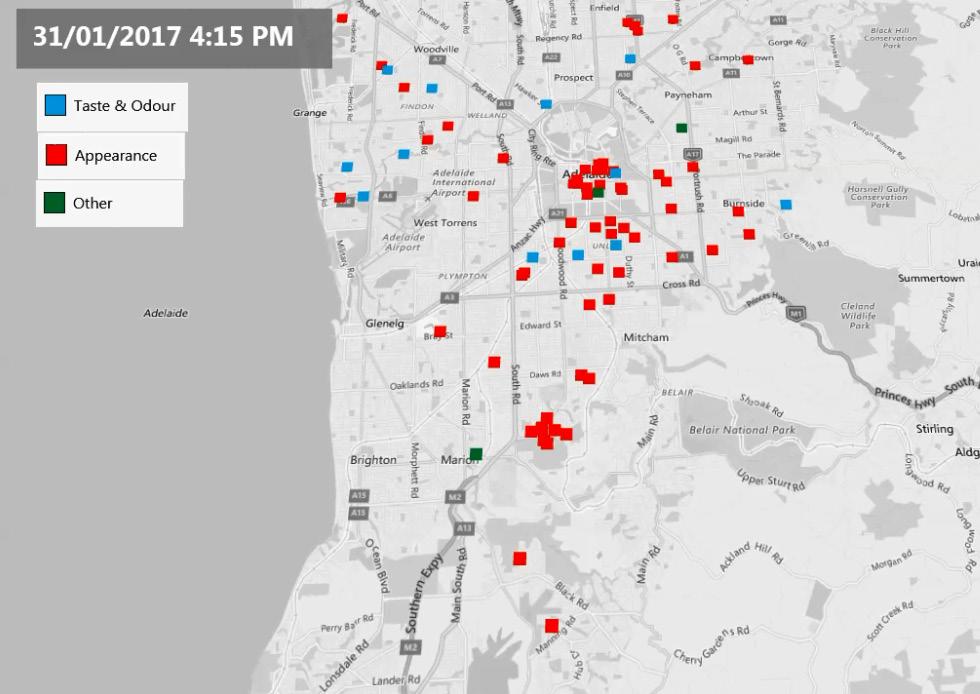
ACCM - Mapping three categories of water quality customer complaints
Award Objectives
• To create an opportunity which encourages water industry operational staff to share their in-the-field innovations and/ or fixes to problems so that others in the water industry can benefit.
• To provide an application process which is easy to complete and utilises a standard template. This will give all water industry operational staff the same opportunity for presenting their innovation.
• To provide the opportunity for operational staff to receive recognition for their innovation and efforts.
• To encourage operational staff to become aware of and involved with the Water Industry Operators Association of Australia (WIOA).
To allow WIOA to share the good ideas and innovations with other members through the Operator magazine and/or other publications.
The Process
The PASS application template and more details on the Award can be found on the WIOA web site or from the WIOA office.
Judging
All PASS applications received in the 12 month period ending 1st March annually, will be assessed by an independent panel on a number of criteria, including:
• Commonality of the problem
• Benefit to OH&S, water quality, and/or the environment
• Financial and sustainability benefits
• Application to other industries
• Uniqueness, adaptability and simplicity
Reward
The person who submits the PASS application deemed best in that particular year will be announced the winner of the PASS Award at the annual WIOA NSW Conference. Aqualift Project Delivery Pty Ltd, as the PASS Award sponsor, will provide sponsorship of $2,500 for the winner to join the WIOA team on their annual operational tour of New Zealand including attendance at the New Zealand WIOG operations conference.
Previous Winners
2018 Michael Cartmer, Quinton Caird, Martin Zardins, Stephen Casey & Michael Dixon Power & Water
2017 Marcus Boyd Toowoomba Regional Council
2016 Daren Lord TasWater
2015 Frank Rinaldo North East Water
2014 Lester Little TasWater
2013 Terry Randall & Danny Roberts Port Macquarie Hastings Council
2012 Mark Walker Gippsland Water
2011 Wayne Shaw Gippsland Water
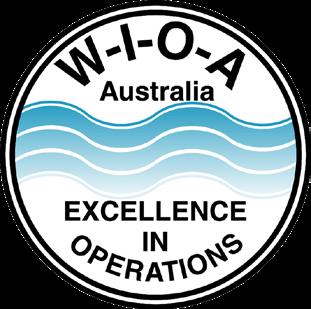
Become a Certified Operator
• Water Treatment
• Wastewater Treatment
• Recycled Water Treatment
The WIOA Water Industry Operator Certification Scheme is an independent confirmation of the training, skills and competence of treatment operators employed by a water business.
Certified operators raise the level of professionalism in the water industry and demonstrate a commitment to excellence by continually updating and improving their knowledge and skills.




Businesses can be comfortable in the knowledge employees have the right qualifications and skills for the job and are committed to excellence in their role.
The Environment will be better off as well-informed operational practices can prevent inappropriate offsite discharges, conserve water and avoid damage to aquifers and waterways.
Consumers will be confident in the knowledge that their systems are operated by a certified specialist who has the skills and experience necessary to make the right decisions in managing a system efficiently, effectively and with minimal impact on public health.

